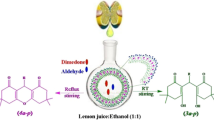Summary
Iodine, in the presence of hot alcoholic sodium acetate, is shown to be a convenient reagent for the conversion of hydroxy flavanones into flavones. Naringenin, its 4′ and 4′: 7-dimethyl ethers, hesperetin and its dimethyl ether are thus oxidised smoothly into apigenin and its ethers and diosmetin respectively. The method is also suitable for glycosides; examples chosen are naringin, its monomethyl ether and hesperidin. The constitution of apiin is discussed and confirmed by correlation with that of naringin.
The method works smoothly in all cases where a free hydroxyl is present in the 5-position. In its absence a mixture is formed; by working in the cold the flavones can be obtained, whereas in the hot benzalcoumaranones could be isolated. In such cases the suitability of the phosphorus pentachloride method has been tested using 7-methoxy flavanone.
The reaction is considered to involve (1) iodination of the 3-position and (2) elimination of hydriodic acid and these are brought about smoothly with the help of the active and unstable acetate ions. If the second stage involves iodinated flavanone, flavone is obtained; on the other hand if the corresponding iodinated chalkone is present, benzal-coumaranone results.
Similar content being viewed by others
References
RobinsonNature, 1936,137, 172. Robinson,et al. Phil. Trans. Roy. Soc., 1939,230 B, 149.
Feuerstein and KostaneckiBer., 1898,31, 1757.
Kostanecki and TamborIbid.,, 1899,32, 2263. Cullinane and PhilpottJ.C.S., 1929, 1761. WheelerProc. Nat. Inst. Sci. (India), 1939,5, 267.
Mahal, Rai and VenkataramanJ.C.S., 1935, 866.
Kostanecki, Levi and TamborBer., 1899,32, 326.
Zemplen and BognarIbid.,, 1943,76, 452.
HattoriActa. Phyto. Chim., 1925,2, 99.
ButenandtAnn., 1928,464, 270. LaForge and SmithJ.A.C.S., 1930,52, 109.
Von GerichtenBer., 1900,33, 2908.
Perkin and HorsfallJ.C.S., 1900,77, 1315.
Rangaswami, Seshadri and VeeraraghaviahProc. Ind. Acad. Sci., A, 1939,9, 328. Narasimhachari and SeshadriIbid., Proc. Ind. Acad. Sci., A, 1948,27, 223.
PerkinJ.C.S., 1897,71, 805.
Chakravarti and GhoshJ.I.C.S., 1944, 171.
Czajnowski, Kostanecki and TamborBer., 1900,33, 1996.
Robinson and VenkataramanJ.C.S., 1926, 2344. Rao, Seshadri and ViswanadhamProc. Ind. Acad. Sci. A, 1949,29, 72.
Oestrele and WanderHelv. Chim. Acta., 1925,8, 519.
Shinoda and SatoJ. Pharm. Soc. Japan, 1929,49, 71.
NakaokiIbid.,, 1938,58, 639.
Kostanecki, Lampe and TamborBer., 1904,37, 1402.
Geissman and FukushimaJ.A.C.S., 1948,70, 1686.
Freudenberg and KammulerAnn., 1927,451, 209.
Author information
Authors and Affiliations
Additional information
An erratum to this article is available at http://dx.doi.org/10.1007/BF03048801.
Rights and permissions
About this article
Cite this article
Narasimhachari, N., Seshadri, T.R. A new synthesis of flavones. Proc. Indian Acad. Sci. (Math. Sci.) 30, 151–162 (1949). https://doi.org/10.1007/BF03049180
Received:
Issue Date:
DOI: https://doi.org/10.1007/BF03049180




